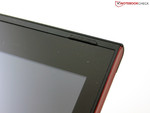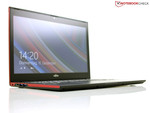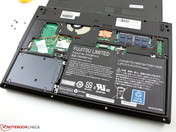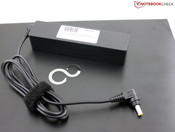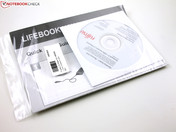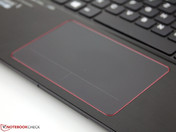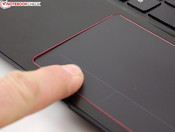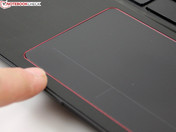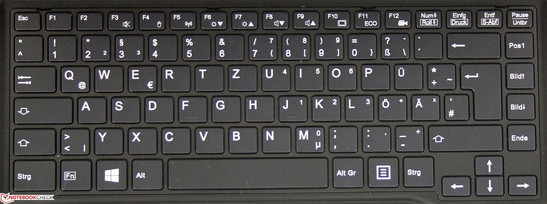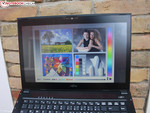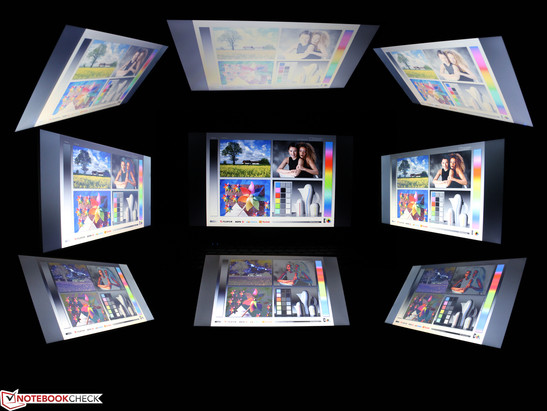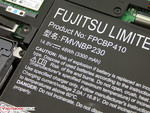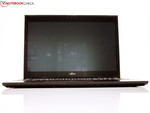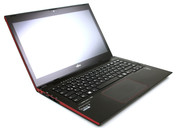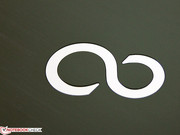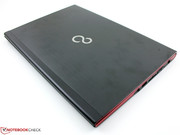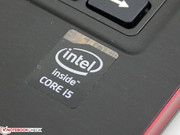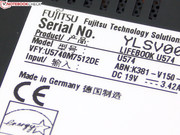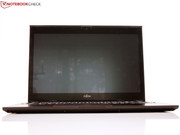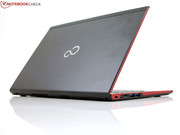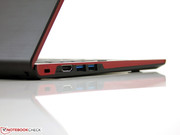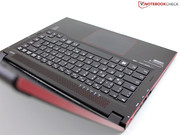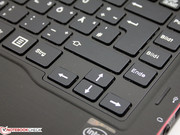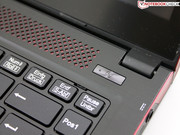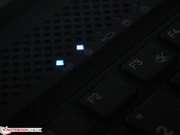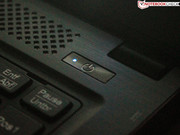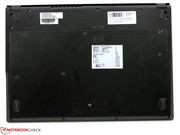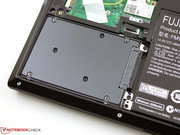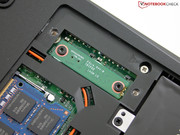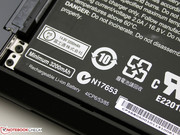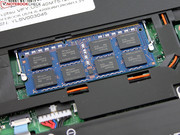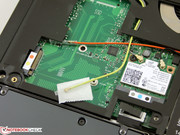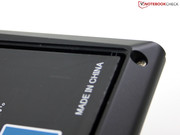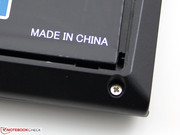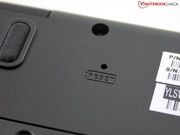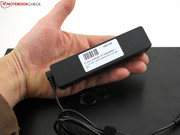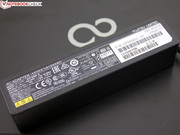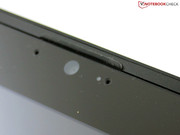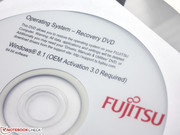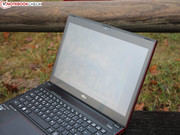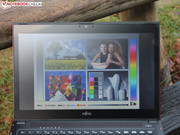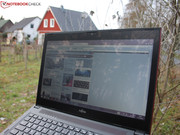Fujitsu Lifebook U574 Ultrabook Review

For the original German review, see here.
Fujitsu has been focusing on business for some years now and has countless devices for both professional users and home office workers in its "Client Computing Devices" section. The Lifebook U574 is a member of the Advanced division, which Fujitsu sees as the office mid-range. The U574 touchscreen ultrabook features a 13.3-inch HD screen and a Core i5. The installed SSD clearly boosts the price (RRP: 899 Euros, ~$1071) compared with the basic configuration (RRP: 699 Euros, ~$833). There are no alternatives for either the screen or the processor. However, there are options for the 3G modem and TPM module. The matte touchscreen is undoubtedly the highlight of the review sample, though it is only available as a TN model.
The Lifebook U574 only has to face a handful of contenders from the 13-inch mid-range office devices in the 900-Euro (~$1073) price range. 14-inch notebooks are still typically used as mobile office devices. We used the AsusPro Essential PU301LA and Toshiba's Portégé R30-A-17G for comparison. The PU301LA has good input devices but has shortcomings in both screen and build. The entry-level configuration of the Portégé R30-A is available for a price starting at about 900 Euros (~$1073). It offers more connectivity than Fujitsu's review sample with a real docking port, a battery life of beyond ten hours, and an optical drive.
Business
- Asus AsusPro Essential PU301LA-RO018G (740 Euros, ~$882)
- Toshiba Portégé R30-A-17G (900 Euros, ~$1073, test: FHD, i7 version)
Consumer with office qualities (good input devices, matte screen)
- Asus Zenbook UX303LA-RO280H (IGP, 700 Euros, ~$834; test UX303LN-R4141H w/ GeForce 840M)
- Acer Aspire V3-371-55GS (IGP, FHD, 700 Euros, ~$834)
- Acer Aspire V3-371-38ZG (Iris Graphics 5100, FHD, 600 Euros, ~$715)
- Lenovo M30-70 (i3, HD, 600 Euros, ~$715)
Case
Fujitsu has really tried to design a casing that wins both business customers and trend-following private users. The combination of matte, brushed aluminum finish (B-cover, display back) and red side strips looks impressive without excessive use of high-gloss. The underside is made of hard, matte plastic. The device's low weight of 1.6 kilograms makes it pleasant to hold, but it has sharp edges. Fingerprints will soon accumulate on the lid.
While the gaps, looks, and materials are first-rate, the stiffness is disappointing. This is still acceptable for the thin lid; it does not dent when light pressure is applied in the middle. However, the base warps every time the device is picked up, and especially when it is held in one corner. This is a minus point for quality impression, although it will not affect the U574's service life.
Connectivity
The clear white labeling of the ports in the work area is striking. Though it facilitates connecting the plugs, it ruins the otherwise homogeneous, restrained looks. The number and type of ports do not go beyond the normal standard of consumers. Quite the opposite since there is no RJ45 Ethernet. Fujitsu recommends its own USB-to-Ethernet dongle for this.
Communication
Fujitsu installs the Intel Dual Band Wireless-N 7260 adapter that also adds Bluetooth 4.0. The reception was excellent. We still had 2 signal bars beyond our 40-meter point outdoors and could still open Notebookcheck.com with a reduced speed. Only one of ten review samples achieves this high range. Laptops with an aluminum lid usually have problems. However, Fujitsu has taken precautions and installs a plastic bar which conceals the antennas in the lid's upper edge. Our review sample did not have a UMTS/HSDPA modem, but the 899-Euro (~$1071) model that the manufacturer sells features one. The two installed antennas and the M.2 slot can be seen in the screenshot of the opened U574.
Security
Multiple device setting and security features can be opened in the BIOS. The U574 is clearly superior to consumer models in this point. However, most business devices also offer that. The TPM module or event log is found here, for example. Wi-Fi, Bluetooth, camera and the USB 3.0 controller can be disabled separately in the BIOS. Setting a drive password is just as possible as Secure Boot. Intel's platform includes Advanced Theft Protections. The splash water-proof keyboard and the Kensington lock are also part of the security features.
Maintenance
The U574 is easy to open. A 2.5-inch SATA slot with the SSD, the Wi-Fi module, an empty M.2 slot (4G modem), working memory (1x 8 GB inserted), and the TPM module are found underneath the aluminum plate. These components and the battery can be replaced, but not the processor. The fan can be accessed and cleaned with compressed air.
Accessories
Only the 65-watt power supply and a recovery DVD for Windows 8.1 Pro 64-bit are part of the included accessories by standard. Fujitsu has a rather general and not device specific accessory program with a Supreme Case, USB 3.0 Gigabit LAN adapter, screen protectors, wireless mice, the PRO8 USB 3.0 port replicator, and external multi-DVD drive.
Warranty
Depending on the country, the warranty period is one year. A one-year bring-in service is valid in Germany. These short periods are common for business devices, and customers can buy optional support packs, such as the 3-year on-site NBD service plan for 207 Euros (~$246). That includes service on the next business day (working hours).
Webcam
The camera shoots unspectacular pictures in 1280x720 pixels. No matter whether artificial or natural light, the areas are extremely faded, objects have coarse outlines, and the colors look very pale as if they are covered by a veil. The latter might be due to the anti-glare sheet that is glued over the webcam. Be that as it may, the pictures taken with this webcam are not even suitable for eBay snapshots. We ask ourselves when manufacturers will finally dare leaving away the camera. Considering that every smartphone shoots better pictures, why should this bad webcam be used?
Input Devices
Keyboard
The rich, bright key lettering in the charcoal black-colored work area strikes the eye right away. Users who do not touch-type will find this relieving. The keys need a clear labeling because there is no backlight like usually found in expensive business devices. The keys are fitted in a flat recess; a matte plastic grid underlines the chiclet design. The keys are absolutely even and feature a rough plastic surface. Strong pressure first causes the area to yield when typing. The stroke is soft and slightly spongy. The drop - which is our biggest complaint - is very short and leads to an unsatisfactory typing feel in conjunction with the short pressure point. The standard layout is interesting for professional users since the position keys, CRTL and DEL are exactly where expected. The arrow keys are a bit longer and can thus be used well without looking. Some letter keys are mapped with a number pad as a second assignment.
Touchpad
Unlike many other key-less pads, the ClickPad fully convinced the tester. It has a pleasantly matte surface with a palpable friction. The diagonal is 12.5 centimeters. The upper third of the pad does not have a drop and can first be pressed in the center and lower areas. Although the drop is short, a quickly responding pressure point and firm stroke make working with the pad enjoyable for the fingers. The large, labeled keys allow traditional drag & drop. The latter can also be performed by pressing the pad's center and a gesture.
Touchscreen
Fujitsu is one of the few manufacturers that offer a non-glare screen for business touch devices. This is achieved with a sheet that is fitted precisely up into the edges. It would not be obvious that it is a sheet if it were not for the microphone holes. The AR coating cannot completely prevent reflections, but it reduces the impact of fingerprints considerably. The capacitive, 10-finger screen implements gestures quickly, and it is sensitive into its corners and edges.
Display
The 13.3-inch screen with a 16:9 aspect ratio has a traditionally coarse resolution of 1366x768 pixels. A sheet makes the LGD0354 capacitive, 10-finger touchscreen non-glare. It is a TN screen with the typical limited viewing angles and usual disappointing weak contrasts. This is also the case in the U574 with 154:1. A black level of 1.27 cd/m² could not be worse, either. The contrast of the Portégé R30-A-15C looks better, but we assessed the expensive FHD IPS version at the time.
| |||||||||||||||||||||||||
Brightness Distribution: 79 %
Center on Battery: 195 cd/m²
Contrast: 154:1 (Black: 1.27 cd/m²)
ΔE ColorChecker Calman: 10.41 | ∀{0.5-29.43 Ø4.77}
ΔE Greyscale Calman: 11.21 | ∀{0.09-98 Ø5}
36% AdobeRGB 1998 (Argyll 1.6.3 3D)
39.49% AdobeRGB 1998 (Argyll 3D)
57.5% sRGB (Argyll 3D)
38.22% Display P3 (Argyll 3D)
Gamma: 2.42
CCT: 12029 K
| Fujitsu Lifebook U574 HD Graphics 4400, 4200U, Samsung SSD PM851 128 GB MZ7TE128HMGR | Asus ASUSPRO Essential PU301LA-RO064G HD Graphics 4400, 4500U, Toshiba MQ01ABF050 | Toshiba Portege R30-A-15C HD Graphics 4600, 4600M, Samsung PM851 Series MZMTE256HMHP | Acer Aspire V3-371-38ZG Iris Graphics 5100, 4158U, Kingston RBU-SC100S37240GE | |
|---|---|---|---|---|
| Display | 10% | 78% | 13% | |
| Display P3 Coverage (%) | 38.22 | 42.06 10% | 69.5 82% | 43.23 13% |
| sRGB Coverage (%) | 57.5 | 62.8 9% | 98.1 71% | 64.8 13% |
| AdobeRGB 1998 Coverage (%) | 39.49 | 43.5 10% | 71.3 81% | 44.7 13% |
| Screen | 9% | 134% | 41% | |
| Brightness middle (cd/m²) | 195 | 247 27% | 314 61% | 230 18% |
| Brightness (cd/m²) | 175 | 235 34% | 288 65% | 220 26% |
| Brightness Distribution (%) | 79 | 87 10% | 87 10% | 91 15% |
| Black Level * (cd/m²) | 1.27 | 1.37 -8% | 0.26 80% | 0.56 56% |
| Contrast (:1) | 154 | 180 17% | 1208 684% | 411 167% |
| Colorchecker dE 2000 * | 10.41 | 12.04 -16% | 4.79 54% | 8.4 19% |
| Greyscale dE 2000 * | 11.21 | 11.75 -5% | 6.71 40% | 9.95 11% |
| Gamma | 2.42 91% | 2.87 77% | 2.54 87% | 2.19 100% |
| CCT | 12029 54% | 13613 48% | 6697 97% | 10109 64% |
| Color Space (Percent of AdobeRGB 1998) (%) | 36 | 40 11% | 64 78% | 41 14% |
| Color Space (Percent of sRGB) (%) | 98.1 | |||
| Total Average (Program / Settings) | 10% /
9% | 106% /
119% | 27% /
33% |
* ... smaller is better
Though the brightness of the AsusPro Essential PU301LA is slightly better, its contrast is just as abysmal. As expected, the color spaces are extremely low; sRGB is covered by 52%. The Aspire V3-371-38ZG also features a TN screen, but it is a Full HD model. It proves that TN does not inevitably have to represent the bottom of the barrel in screen production. It has a better contrast and its color accuracy is a touch better.
The anti-glare coating ensures useful visibility in daylight despite the low brightness. Our screenshots were taken in cloudy condition; direct sunlight would also lead to extreme illegibility of the U574.
The meager viewing angles and contrast shifts when looking from the sides are typical for TN. The user does not have much elbowroom with the U574. The best view on the desktop is only achieved from the front. Many consumer laptops with IPS for considerably less than 900 Euros (~$1073) are better equipped in this regard. Business laptops with IPS, and then also frequently with FHD, cost beyond 1000 Euros (~$1192) and are usually only available in 14 or 15-inches.
Performance
There are no options for the Core i5-4200U (native: 1.6 GHz; Turbo 2.6 GHz) in the U574 because it is soldered. Fujitsu does not offer any alternatives. Our review sample with a Samsung SSD PM851 (128 GB) alongside the low-voltage processor from the Haswell architecture should achieve a good application performance that will equip buyers very well for many years. 8 GB of working memory in single-channel mode (one module) and the integrated Intel HD Graphics 4400 complement that. The latter will not lead to any performance miracles, but it keeps the power consumption low.
Processor
The Turbo should theoretically clock with up to 2.6 GHz (single-core), which our tests do not confirm. Cinebench R11.5 operated with a stable 2.3 GHz in single-mode. However, the clock rate was no longer stable in multi-core load of the same test. It regularly repeatedly dropped to 800 MHz. Since the same Cinebench Multi scores were achieved in battery mode, we assume the same clock behavior.
The comparison with the contenders shows that the U574 is not much better than the Core i3-4158U in the Aspire. The slightly higher-clocked i7-4510U calculates 25 to 40% faster. Buyers get a Core i7-4500U that computes 18 to 40% (single/multi) faster for less money with the AsusPro Essential PU301LA.
System Performance
PCMark7 and PCMark 8 provide an outlook on the application performance. Does the weak processor have an adverse impact on the overall performance? That is apparently not the case. Like HP's Pavilion 15-n005sg with the same processor shows in the Computation score, the result is identical. Interesting: The AsusPro Essential PU301LA boasts with a Core i7, but PCMark 7 and 8 deliver considerably worse results also in the Computation score. The PU301LA did not suffer under throttling, and the Cinebench scores above are better than those the review sample reaped in. The results of different benchmarks are off-balance. The Core i7 in Toshiba's Portégé R30-A-15C is slightly better, but the difference is a low 10%. Potential buyers thus will not miss an i7 alternative.
| Fujitsu Lifebook U574 | Asus ASUSPRO Essential PU301LA-RO064G | Toshiba Portege R30-A-15C | Asus Zenbook UX303LN-R4141H | Acer Aspire V3-371-38ZG | Lenovo M30-70 | HP Pavilion 15-n005sg | |
|---|---|---|---|---|---|---|---|
| PCMark 7 | -44% | 30% | 4% | -45% | -35% | ||
| Score (Points) | 4236 | 2475 -42% | 5068 20% | 4037 -5% | 2259 -47% | 2680 -37% | |
| Productivity (Points) | 2302 | 1511 -34% | 4146 80% | 3226 40% | 1239 -46% | 1565 -32% | |
| Creativity (Points) | 8090 | 4679 -42% | 9720 20% | 7961 -2% | 4618 -43% | 5284 -35% | |
| Computation (Points) | 13526 | 9300 -31% | 17372 28% | 12251 -9% | 10972 -19% | 13379 -1% | |
| System Storage (Points) | 5157 | 1569 -70% | 5244 2% | 5010 -3% | 1468 -72% | 1520 -71% | |
| PCMark 8 | -6% | 10% | 18% | -7% | -13% | ||
| Home Score Accelerated v2 (Points) | 2240 | 2111 -6% | 2493 11% | 2927 31% | 2172 -3% | 2023 -10% | |
| Work Score Accelerated v2 (Points) | 3400 | 3702 9% | 3559 5% | 3065 -10% | 2864 -16% | ||
| Total Average (Program / Settings) | -25% /
-38% | 10% /
10% | 24% /
27% | -2% /
1% | -29% /
-36% | -35% /
-35% |
| PCMark 7 Score | 4236 points | |
| PCMark 8 Home Score Accelerated v2 | 2240 points | |
| PCMark 8 Work Score Accelerated v2 | 3400 points | |
Help | ||
Storage Devices
The Samsung SSD PM851 (128 GB) is installed as a normal 2.5-inch SATA drive. The read and write rates are very decent. HDD-based systems like the PU301LA lag far behind. The Portégé R30-A-15C (also Samsung PM851, different model) and Zenbook UX303LN exemplarily show that better SSDs are available. Both provide higher rates in Write 512 and Write 4K.
| Fujitsu Lifebook U574 | Asus ASUSPRO Essential PU301LA-RO064G | Toshiba Portege R30-A-15C | Asus Zenbook UX303LN-R4141H | Acer Aspire V3-371-38ZG | |
|---|---|---|---|---|---|
| AS SSD | 20% | 26% | -7% | ||
| Seq Read (MB/s) | 477.7 | 514 8% | 437 -9% | 508 6% | |
| Seq Write (MB/s) | 134.5 | 251.6 87% | 427.7 218% | 285.2 112% | |
| 4K Read (MB/s) | 32.04 | 13.08 -59% | 29.76 -7% | 25.1 -22% | |
| 4K Write (MB/s) | 81.7 | 101.1 24% | 83.2 2% | 61.2 -25% | |
| Access Time Read * (ms) | 0.092 | 0.073 21% | 0.086 7% | 0.116 -26% | |
| Access Time Write * (ms) | 0.041 | 0.033 20% | 0.045 -10% | 0.057 -39% | |
| Score Read (Points) | 429 | 448 4% | 399 -7% | 233 -46% | |
| Score Write (Points) | 213 | 328 54% | 289 36% | 226 6% | |
| Score Total (Points) | 855 | 1003 17% | 903 6% | 576 -33% | |
| CrystalDiskMark 3.0 | -85% | 24% | 33% | 5% | |
| Read Seq (MB/s) | 534 | 100.8 -81% | 537 1% | 409 -23% | 511 -4% |
| Write Seq (MB/s) | 141.5 | 92.5 -35% | 268 89% | 436.6 209% | 308.3 118% |
| Read 512 (MB/s) | 434.7 | 30.05 -93% | 463 7% | 301.1 -31% | 316.6 -27% |
| Write 512 (MB/s) | 141.3 | 39.38 -72% | 267.5 89% | 373 164% | 307.6 118% |
| Read 4k (MB/s) | 34.99 | 0.371 -99% | 38.11 9% | 34.64 -1% | 20.98 -40% |
| Write 4k (MB/s) | 95.8 | 0.816 -99% | 126 32% | 100.7 5% | 72.3 -25% |
| Read 4k QD32 (MB/s) | 365.6 | 0.813 -100% | 382.7 5% | 347.8 -5% | 148.1 -59% |
| Write 4k QD32 (MB/s) | 441.1 | 0.849 -100% | 264.1 -40% | 199.8 -55% | 253 -43% |
| Total Average (Program / Settings) | -85% /
-85% | 22% /
22% | 30% /
29% | -1% /
-2% |
* ... smaller is better
Graphics Card
The HD 4400 graphics card can only make use of a single-channel memory (only one RAM bar possible), which limits its computing performance by roughly 20%, as experience shows. Devices with an HD 4600 perform marginally better even without dual-channel (Portégé R30-A-15C). The PU301LA also only has one memory bank but achieves a 20% higher score in the synthetic benchmarks (summarily). The reason might be the U574's GPU clock of 1000 MHz; the PU301LA calculates a bit faster with 1100 MHz.
| 3DMark 11 Performance | 832 points | |
| 3DMark Ice Storm Standard Score | 28472 points | |
| 3DMark Cloud Gate Standard Score | 3526 points | |
| 3DMark Fire Strike Score | 502 points | |
Help | ||
Gaming Performance
In view of the integrated graphics and in particular a relatively slow HD 4400, games will not be a topic as our random tests prove. Users who want to play on their handy ultrabook will need at least a GeForce 840M like in the Zenbook UX303LN. Otherwise, the Intel graphics is on the level of a brand new HD Graphics 5300 (Core M, Broadwell), like the Venue 11 Pro shows.
| Sleeping Dogs - 1024x768 Low Preset AA:Normal (sort by value) | |
| Fujitsu Lifebook U574 | |
| Acer Aspire V3-371-38ZG | |
| Dell Venue 11 Pro 7140 | |
| HP ProBook 470 G2 G6W52EA | |
| Middle-earth: Shadow of Mordor - 1280x720 Lowest Preset (sort by value) | |
| Fujitsu Lifebook U574 | |
| Dell Venue 11 Pro 7140 | |
| Asus ASUSPRO Advanced BU401LA-CZ020G | |
| Dell Latitude E5550 | |
| Asus Zenbook UX303LN-R4141H | |
| low | med. | high | ultra | |
|---|---|---|---|---|
| Sleeping Dogs (2012) | 20.2 | 14.8 | 8.4 | |
| Middle-earth: Shadow of Mordor (2014) | 21.4 | 10.76 | ||
| Alien: Isolation (2014) | 20 | 18.5 |
Emissions
System Noise
The Lifebook's noise development is overall low; we only measured 35 dB(A) in the stress test. That is very little, but throttling (CPU: 800 MHz) drastically reduces the waste heat production. The U574 is absolutely silent when idling, and the fan is mostly disabled. That is not the case in either the Protégé R30-A or PU301LA. The option Fan Control is found in the BIOS (Silent, Normal), whereas Silent is set by default. We performed all tests using this setting.
Noise level
| Idle |
| 29.6 / 29.6 / 32.5 dB(A) |
| Load |
| 35 / 35.4 dB(A) |
 | ||
30 dB silent 40 dB(A) audible 50 dB(A) loud |
||
min: | ||
Temperature
The surface temperatures are in line with the system noise in load and idle mode. We measured a maximum of 43 °C (load) and 42 °C (idle). The waste heat of the contenders is not much higher, not even that of the R30 despite its 35-watt CPU. Both the Satellite and AsusPro Essential PU301LA have thicker base units and can thus deal with waste heat easier.
How does the U574 behave in the stress test, an unrealistic scenario that puts the GPU and CPU under consistent, simultaneous load? The CPU settled to 800 to 1000 MHz after a while, and the GPU ran with a stable 1000 MHz. The base clock of 1.6 GHz is clearly undercut. We not only ascertained this drastic drop in the clock rate during the stress test. A singly performed Prime95 multi-test also caused the clock to fluctuate between 800 MHz and 2.3 GHz. Here, thermal limits of presumably about 75 °C are surpassed on the SoC. The CPU heated up to a maximum of 79 °C in the stress test. A CPU benchmark performed right after the stress test finished with the normal cold start score. The thermal load thus does not have any direct side effects, and non-throttling temperatures are reached quickly again.
(±) The maximum temperature on the upper side is 42.7 °C / 109 F, compared to the average of 35.9 °C / 97 F, ranging from 21.4 to 59 °C for the class Subnotebook.
(±) The bottom heats up to a maximum of 41.9 °C / 107 F, compared to the average of 39.3 °C / 103 F
(+) In idle usage, the average temperature for the upper side is 25.4 °C / 78 F, compared to the device average of 30.8 °C / 87 F.
(+) The palmrests and touchpad are cooler than skin temperature with a maximum of 25.5 °C / 77.9 F and are therefore cool to the touch.
(+) The average temperature of the palmrest area of similar devices was 28.2 °C / 82.8 F (+2.7 °C / 4.9 F).
Speakers
The speakers produce a thin, monotone sound that is unsuitable for music or videos. Headphones should be used for these intentions. Bass and differentiated trebles are non-existent. The maximum volume is only moderate so that the speakers above the keyboard do not distort.
The stereo microphones are located left and right of the webcam. Only two centimeters separate them. Voice recordings sound tinny, and an electric hum permanently affects the quality. The recordings are consistently loud even when the speaker increases the distance from 0.5 to 3 meters and run through the room.
Energy Management
Power Consumption
The Lifebook really does its best in battery life and translates its relatively low 48 Wh into a very good six hours in the Wi-Fi test. Thus, it pulls even with the Portégé R30-A-15C, standard-voltage system (Reader's/idle) that, however, needs 66 Wh. The very low power consumption in both idle and load corresponds to the long battery runtimes of the test system. The R30, however, takes a 60% lead in the Wi-Fi test. The PU301LA cannot compete with that; the Asus contender only manages an hour less in the Wi-Fi test.
| Fujitsu Lifebook U574 | Asus ASUSPRO Essential PU301LA-RO064G | Toshiba Portege R30-A-15C | Asus Zenbook UX303LN-R4141H | Acer Aspire V3-371-38ZG | Lenovo M30-70 | |
|---|---|---|---|---|---|---|
| Power Consumption | -59% | -49% | -51% | -46% | -14% | |
| Idle Minimum * (Watt) | 3.1 | 6.5 -110% | 5 -61% | 3.8 -23% | 3.4 -10% | 3.9 -26% |
| Idle Average * (Watt) | 5.2 | 9.8 -88% | 8.4 -62% | 7.2 -38% | 5.9 -13% | 5.6 -8% |
| Idle Maximum * (Watt) | 6.3 | 10.4 -65% | 8.6 -37% | 8.4 -33% | 8.3 -32% | 8.4 -33% |
| Load Average * (Watt) | 25.3 | 26.5 -5% | 34.9 -38% | 41.6 -64% | 48.6 -92% | 20.9 17% |
| Load Maximum * (Watt) | 26.4 | 33.1 -25% | 38.9 -47% | 51.9 -97% | 48.4 -83% | 32.1 -22% |
* ... smaller is better
| Off / Standby | |
| Idle | |
| Load |
|
Key:
min: | |
Battery Runtime
The long 65-watt power supply easily copes with the power requirement. Recharging during load or a stress test would be possible in view of a power consumption of just 25 to 26 watts. The U574 needs a whole 2:20 hours for recharging the battery. That is relatively long for the low capacity, but slow charging conserves the battery.
The low load maximum power consumption of only 26 watts is conspicuous. The direct contenders need 25 to 47% more. The reason for the U574's modesty is the massive throttling in the stress test. However, the load average is on par with the category average. Toshiba's R30 steps out of line with its 35-watt processor, the Zenbook UX303LN sports a GeForce 840M, and the Aspire V3-371-38ZG an Iris Graphics 5100.
Verdict
Fujitsu has a portable subnotebook in its lineup with the Lifebook U574. It convinces in some but not all fields. The list of pros is led by looks and weight and continues with runtime, emissions, maintenance, and the ClickPad.
The manufacturer still owes the buyer a few things for the to-be state, but the competition does not always offer them, either. The base unit is simply too pliable for professional use, which does not make a good impression for the quality of the relatively expensive ultrabook. The keys provide comparatively little feedback, and the webcam's quality is beyond any description. The microphone recordings are just as bad as the speakers' sound, and the weak TN screen with the abysmal contrast and limited viewing angles does not give reason for joy in view of the IPS screen diversity in the consumer sector.
Buyers who can live with a TN screen could opt for the less expensive AsusPro Essential PU301LA-RO064G, which comes with a better keyboard (keyboard with clear drop and crisp pressure point). Fans of good screens should avoid the review sample and invest a bit more money in Toshiba's Portégé R30-A-15C with an IPS screen. Though the keyboard is not much better, the microphone, battery life, and interface diversity are superior.




